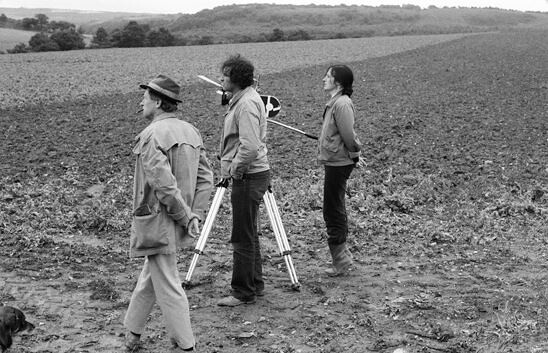

Danièle Huillet and Jean-Marie Straub on the set of Too Early, Too Late, 1981.
Letter from Danièle Huillet to the London film distributor, Andi Engel of Artificial Eye, who helped sell Straub-Huillet’s Too Early, Too Late (1981) to ARD, the first German TV network. First published in Italian in Filmcritica, no. 322 (February–March 1982), where it was translated from German by Danièle Huillet.
***
June 6, 1981
(after the shoot, before the editing)
Dear Andi,
You’ve asked me to write a page in which we’d explain what our “intention” was in making this film or what we wanted to “express” with it. It has always been difficult for us, you know, to affirm this kind of thing with regards to our films and we have almost always refused to do so; but in this case (Too Early, Too Late), this impossibility is even greater because up until now in none of our films has everything been so “open,” so free, so that it is the spectators themselves (and the two of us as the first spectators) who must establish the links, relations, “relationships,” and learn to decipher, make connections, and “interpret” reality or, better yet, the realities! Moreover, this is not “fiction” but what is called “documentary,” even if this way of documenting is, I believe, new (though it has precedents: for example, La Sortie de l’usine Lumière [Workers Leaving the Lumière Factory])—no “restrictive” narration, no actors. What is recounted: struggles, revolts, defeats, delays and anticipations, statistics; what is represented: history, topography, geography, geology, light, lights, wind and clouds, land (transformed and worked by men), traces—erased or still visible—and sky (lots of sky); we tried finding the right perspective (the only one), the right height, the right proportions between the earth and the sky, to be able to pan without having to change the horizon line, even at 360-degrees.
We see many theaters of oppression and rebellion. We hear noises of the present, and the class history of France in the months preceding 1789, which is recounted through a text by Friedrich Engels and with a woman’s voice (mine!—in German, English, and Italian with a French accent so there exists a link between the landscapes and names) and then, with a man’s voice with an Arab accent, telling the history of peasant struggles in Egypt and the liberation from Western colonization, but not from class oppression in the country itself.
The differences between historical time and “eternal” time (!)—which is the same, which is completely different where space becomes time (which belongs to history but is also the “essence” of cinema)—and how far we can go in our analysis with precise instruments like a camera and a Nagra, which are never precise enough and nevertheless much more precise than our senses: all this has to be “expressed” one way or another in this film …
Moreover, I can also tell you the story of its genesis: a number of years ago (after Introduction to … Schoenberg, I think, so in 1972), Werner Dütsch asked us if we wanted to shoot, for his television program, a film made entirely of “still images.” Jean-Marie responded that, primo, a film like that already existed (Chris Marker’s La Jetée [The Jetty]); secondo, that he, in fact, hated photography.
Then he shot Moses and Aaron where the discovery of geology mixed with human history takes place in the big panning shot in the first scene (“Call of Moses”) and the discovery of Egypt and its landscapes in the last two panning shots of the first act—and also during the documentation trip we did in 1972. And it was during these years that one day Jean-Marie read the postface to Mahmoud Hussein’s book (in reality, two authors who were imprisoned under Nasser in a concentration camp and today live and work in Paris) Luttes sociales en Egypte1 and he was impressed … The idea was born to return to Egypt to film something about and in Egypt.
Straub, amnestied, was able to return to France—he discovered, thanks to his exile, the stay in Italy (in Germany one learns of the class struggle, but in Italy one learns to see) and in Egypt (meaning Africa and what is still a peasant culture)—his own country. And then Straschek2 presented us with Marx and Engels’s correspondence and one day I read Engels’s letter to Kautsky, which Straub liked a lot—it was also a way of “correcting” nostalgia and linking Paris to the countryside.
And then we shot Fortini/Cani, 1976, which contains the sketch of Too Early, Too Late: the long sequence in the Apuan Alps and Marzabotto (resistance and massacre). And then everything, with a bit of work, was organized, brought together, structured—to lead to what it is today …
Best regards, from Straub as well,
D. H.
Translated from the Italian by Ted Fendt in Jean-Marie Straub and Danièle Huillet, Writings, ed. Sally Shafto (Sequence Press, 2016). Republished by permission of Sequence Press.
This text is published in conjunction with the film series Aesthetics of Resistance: Straub-Huillet and Contemporary Moving-Image Art, taking place at e-flux Screening Room.
La Lutte de classes en Egypte de 1945 à 1968 (Ed. François Maspéro, 1969); Class Conflict in Egypt, 1945–1970 (Monthly Review Press, 1973). Mahmoud Hussein is the pseudonym for Bahgat Elnadi and Adel Rifaat, French political writers of Egyptian origin. —Trans.
Günter Peter Straschek, German filmmaker and film historian who appears in Introduction to Arnold Schoenberg’s “Accompaniment to a Cinematic Scene.” —Trans.